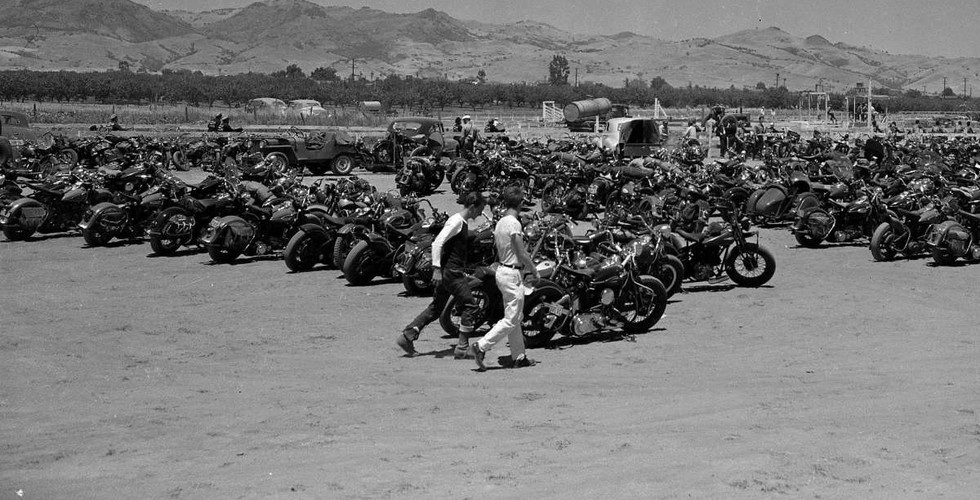Hollister Riot: The Event That Changed Motorcycle History
- Sudip Issac Sam
- Apr 24, 2022
- 6 min read
Updated: May 15, 2022
In the past 100 years or so of motorcycle history, very few incidents have had an impact on its culture as that of the Hollister Riot of 1947. Rooted in both myth as well as reality, it can almost be quoted as an example of the ‘Butterfly Effect’, as the events of a weekend changed the public outlook towards motorcycling culture as a whole for several decades, and led to some interesting developments such as the rise of outlaw biker groups in the US and the entry of Honda and other Japanese manufacturers into the western market.
This interesting story was narrated to me by my reporting manager Mr. Vijay Thomas, Lead Marketing, during my summer internship stint at Harley-Davidson India. Although this topic has been written about many times before, I felt the urge to dig a little deeper and share my own perspective on it.
So how did a seemingly harmless incident at a small town in California change the motorcycling world? Let’s have a look.
The Motorcycle
In 1941, after the attack of the Japanese on Pearl Harbour, the US was pushed into the Second World War. Motorcycles had replaced horses in infantry battalions and Harley-Davidson was conscripted as the motorcycle supplier for the allied war efforts. Around 90,000 units of the 45ci Harley-Davidson WLA aka ‘The Liberator’ were shipped to Europe and other war fronts, many of which the veterans brought back home with them.

The war ended in 1945 with the surrender of Nazi Germany and Imperial Japan. Suffering from PTSD and unable to re-adjust to civilian life, the war veterans found solace in their motorcycles. With leftover pensions and little means for excitement and adventure, they bought back their service motorcycles, removed excess bodywork (aka ‘bobbers'), and started forming motorcycle clubs to rekindle their wartime camaraderie. Small MCs such as 'Jackrabbits', '13 Rebels', and 'Yellow Jackets' started popping up where the members wore club sweaters to the field meets and spent their time usually drinking and partying.
The Incident
It was Friday, the 4th of July 1947. Independence Day celebrations were in full swing and the American Motorcyclist Association (A.M.A) had organized ‘Gypsy Tours’ across the US, which were 3 day-long events comprising of dirt-track racing, hill climbs, and scrambles, held since the 1930s. For Hollister, a small farming community in California of 4500 which had hosted the Gypsy Tours for many years, the event meant more customers and better business.
Bikers had already started pouring into Hollister since the afternoon of the 3rd, arriving from different parts of California like San Francisco, L. A and also including as far as Florida and Connecticut. Initially, the town’s bars and taverns welcomed the guests with open arms but quickly realized that they were overwhelmed when the attendance swelled to more than 4000.
Soon the AMA-sanctioned races were ignored and the inebriated bikers started fighting, crashing into bars, racing full speed through the intersections, and creating a ruckus. The local P.D consisted only of 7 officers who were clearly outnumbered, the local hospital was jammed with injured bikers and a special session of night court was convened for the many arrests of public drunkenness, disorderly conduct, and reckless driving that had taken place.
By Sunday, the show began to lose steam and the California Highway Patrol officers were able to disperse the unruly bikers with a show of force and threats of tear gas. Thankfully, albeit a ton of discarded beer bottles, there was no damage done to the town in terms of property or personal loss. Life returned back to normal at Hollister and the locals moved on with their business the next week. But unfortunately, the press did not.
The Infamous Photo
Initial reports on the incident in local dailies such as the Hollister Freelance were accurately retold and not sensationalized. But on the evening of the 6th, the desire to increase readership for his newspaper prompted Barney Peterson, a photographer from the San Francisco Chronicle, to capture the infamous photo that would go on to imprint the stereotype of bikers as loud, obnoxious, and rowdy in the mind of the public.
The image consisted of an intoxicated-looking man, who is claimed to be Eddie Davenport, with beer bottles in each of his hands and around his Harley-Davidson motorcycle.


The image first got published in the San Francisco Chronicle with sensationalized headings such as "Havoc in Hollister" and "Riots... Cyclists Take Over Town", but then, Life magazine picked up the photo and ran a full-page spread on page 31 the next week, hoping that the image would create more of a furor than the details of the incident.
Although eye-witness testimonies of attendees of the event such as that of August ‘Gus’ Derpa (behind Eddie Davenport in the image) claim that the image was faked by the photographer, the strong nationwide influence of the magazine made sure that the news was a national sensation.
The Aftermath
The AMA was caught in a PR nightmare as the notion that any minute, roving bands of ruthless motorcycle hoodlums might descend upon them, caused towns across the US to cancel race meetings. It was further complicated by the fact that an incident similar to Hollister took place again in 1948 in another town called Riverside.
Although this isn’t corroborated, the legend goes that in order to save their reputation, the A.M.A put out a statement saying that “the trouble was caused by the one percent deviant that tarnishes the public image of both motorcycles and motorcyclists and that the other ninety-nine percent of motorcyclists are good, decent, law-abiding citizens.”
The AMA also went to the extent of discriminating against many of its riders, who wore military jackets with club insignia and rode ‘chopped’ motorcycles, by banning them from attending AMA-sanctioned motorcycle events. This eventually led to these riders embracing their ‘1%’er identity which laid the foundation for the formation of Outlaw Motorcycle Gangs (OMGs).
a). The Big Four
Although there are several others, the big four outlaw MCs are – Hell’s Angels (1950), The Pagans (1959), The Outlaws (1959), and The Bandidos (1966). They started as associations of rebellious bikers, but membership swelled in the 60s & 70s as they attracted many disillusioned veterans of the Vietnam War and other fringe elements ostracized by the society.
Currently, these OMGs have branches in several countries, follow their own rules, resort to extreme violence to control their territory, and are considered dangerous organizations involved in criminal activities that pose a formidable threat to society and law enforcement in general.

b). The Movie
The Hollister event and the outlaw motorcycle culture sparked the imagination of Hollywood directors and in 1953, the ‘Wild One’ was released which starred Marlon Brando as a rebellious outlaw motorcycle gang leader who terrorizes local towns but then falls for the sheriff’s daughter. A biker himself, Brando rode his own Triumph Thunderbird 6T in the movie.

c). The Honda Super Cub
In the 1960s, Honda, the Japanese manufacturer, had set its sights on entering the US market.
By this time, thanks to the prominence of outlaw motorcycle culture and supporting Hollywood productions, if someone owned a motorcycle usually a Harley-Davidson or a Triumph, they were either considered to be a leather-clad ruffian from an illegal biker gang or a Rock-N-Roll star. The motorcycles also were big bulky machines that required constant maintenance, which no one besides the most ardent of enthusiasts would want to own.
On the other hand, Honda envisioned the ‘Super Cub’, a 50cc simple, fun, and low-cost motorcycle for the masses. They enlisted the service of Grey Advertising and together they created a marketing campaign with the slogan – “You meet the nicest people on a Honda”. It was targeted at the average joe – housewives, young couples, students, working men etc, and became so successful that it captured 63% of the US motorcycle market share for Honda from practically nothing. This campaign also played a crucial role in erasing the motorcycle’s deep-rooted image of rebellion in the American collective psyche. So, because of its immense influence, this campaign is still studied in marketing classes as a case study today.
d). The HOG
In 1983, Harley-Davidson was able to successfully shed its past associations with the outlaw biker culture with the establishment of the Harley Owners Group aka the HOG. The club associated itself with various philanthropic efforts and with more than a million members worldwide, acts as a channel for the brand to interact with its fans and get their feedback. It also supports the US military by introducing a number of biking programs to honor veterans for their service.

Epilogue
The Hollister community remained calm through all the pandemonium and 70 odd years after the incident, still hosts biker meets every year as part of the 4th of July Independence Day celebrations. Similar to the Sturgis Rally, attending the event is an annual pilgrimage for motorcycle enthusiasts across the US, as the immense significance of the incident that took place over a weekend in this small town all those decades ago is not lost on them.

































